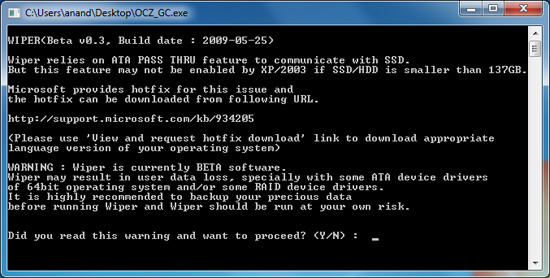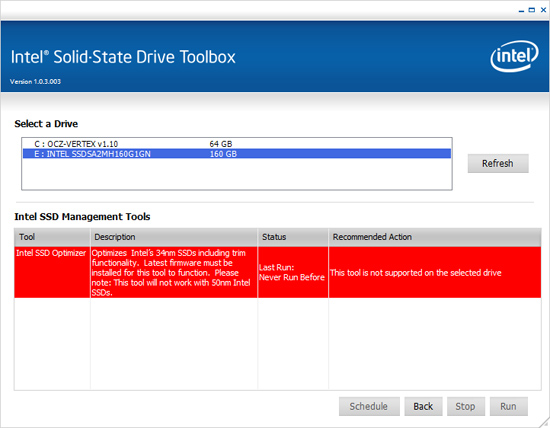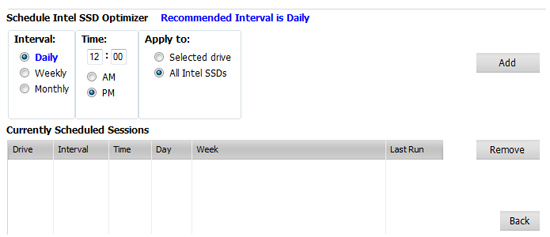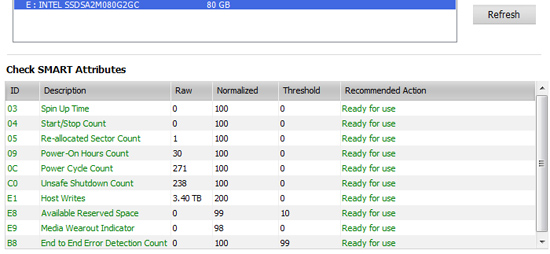The SSD Improv: Intel & Indilinx get TRIM, Kingston Brings Intel Down to $115
by Anand Lal Shimpi on November 17, 2009 7:00 PM EST- Posted in
- Storage
Wipe When You Can’t TRIM
There’s a major problem with TRIM today. The only Windows storage drivers to support it are written by Microsoft. The Intel Matrix Storage Manager (IMSM) driver will not pass the TRIM instruction to your SSD. This means you can't use anything but the drivers that ship with Windows 7. To make matters worse, if you enable non-member RAID on an Intel motherboard the default Windows 7 driver is an older version of IMSM so TRIM won't work there either - even if you don't have a RAID array created. Your best bet is to install Windows 7 with your I/O controller in AHCI mode (for Intel chipsets) and don't install any storage drivers. Intel is working on an updated IMSM that will pass the TRIM instruction to SSDs but it won't be ready for at least a couple of months.
TRIM won't work on a RAID array.
If you want to use IMSM or if you're using Windows XP or Vista, both of which do not support TRIM, there's another option. Earlier this year Indilinx released its Wiper Tool that performs a manual TRIM on their SSDs. It works by asking the OS for a list of the free space addresses on the partition and then sending the list with instructions to TRIM down to the SSD.

The Indilinx Wiper Tool
Today Intel introduces its own manual TRIM tool as a part of the SSD Toolbox:

On any Windows OS (XP, Vista or 7) regardless of what driver you have installed, Intel's SSD Toolbox will allow you to manually TRIM your drive. Intel calls it the SSD Optimizer, which of course only works on 34nm Intel SSDs (X25-M G1 owners are out of luck unfortunately).

The Intel SSD Optimizer lets you schedule the manual TRIM operation automatically
The SSD Toolbox also gives you access to SMART and drive health data, including telling you how many writes you've performed on your SSD, and what your current flash wear level is:

Running Intel's SSD Optimizer does work as advertised. I ran the PCMark HDD suite on a clean X25-M, once more on a drive that had been well used and once more after running the SSD Optimizer:
| PCMark Vantage HDD Score | Clean Run | Used Run | After SSD Optimizer |
| Intel X25-M G2 160GB | 35909 | 30354 | 34014 |
Intel's SSD Optimizer should be able to restore performance to about 95%+ of new, in this case it manages 94.7% - close enough.
Moving On: Forget About Invalid Data and Worry About Free Space
The existence of TRIM changes the way we test, something I alluded to in the SSD Relapse. Thankfully, we come prepared.
In previous articles we had to test SSDs in two conditions: new and used. The new state is just after a secure erase, the used state required us to write data to every user accessible portion of the drive first before benchmarking. The former resulted in great performance, the latter meant the SSD had to do a lot of juggling of existing data whenever it went to write. The second scenario no longer exists with TRIM. The act of formatting your drive or deleting files (and emptying the recycle bin) will TRIM invalid data.
Performance in a TRIM enabled system is now determined not by the number of invalid blocks on your SSD, but rather the amount of free space you have. I went into a deep explanation of the relationship between free space and the performance of some SSDs here.
TRIM will make sure that you don’t have to worry about your drive filling up with invalid data, but it doesn’t skirt the bigger issue: dynamic controllers see their performance improve with more free space.
My rule of thumb is to keep at least 20% free space on your drive, you can get by with less but performance tends to suffer. It doesn’t degrade by the same amount for all drives either. Some controllers are more opportunistic with free space (e.g. Intel), while others don’t seem to rely as much on free space for improved performance. Addressing performance degradation as drives fill up (with valid data) will be one of the next major advancements in SSD technology.










162 Comments
View All Comments
slickdoody - Monday, October 26, 2009 - link
Did Intel remove the SSD toolbox software?The link in the article doesn't work and I can't find the software on the site by searching.
Griswold - Monday, October 26, 2009 - link
Here it is again:http://downloadcenter.intel.com/Detail_Desc.aspx?a...">http://downloadcenter.intel.com/Detail_Desc.aspx?a...
slickdoody - Monday, October 26, 2009 - link
thanks!Sunburn74 - Monday, October 26, 2009 - link
Its absolutely ridiculous how intel is screwing those customers who bought their x25m g1s by specifically going out of their way to prevent trim support. At least give a manual wiper tool, you jerks. Geez!lorax1284 - Tuesday, December 15, 2009 - link
I know that Toms Hardware has commented on the fact that Intel is not providing a firmware update for the X25-m first generation drives... but I think TH is in a position to rake Intel over the coals for this terrible decision! Toms Hardware caters to computer enthusiasts, exactly the type of customers who buy first generation hardware like the X25-m G1... so for Intel to NOT issue a TRIM firmware update for X25-m G1 drives should ahve Toms Hardware users up in arms, and certainly questioning whether Intel's support for the G2 drives will stand the test of time!If you think Intel is wrong to abandon the G1 drives by not providing a TRIM firmware update, please consider signing this petition!
http://www.ipetitions.com/petition/intel-x25-m-g1-...">http://www.ipetitions.com/petition/intel-x25-m-g1-...
cbutters - Monday, November 23, 2009 - link
Agreed 100%, I purchased an x-25m G1 at a premium thinking that intel would take care of me once TRIM support was available. Since I heard that intel wouldn't be giving any G1's trim for no reason other than to screw over the consumer into buying an updated drive, I have only purchased Indilinx based SSDs (over 4 now) and I recommend that everyone else do the same!They also promised that the 80gb G2 SSDs would be sold at a price point of $229, but due to the demand they are gouging everyone selling them at price points of 299 and above. (can't blame them, it's economics, but don't PROMISE it at $229 and not fulfill it.)
People buy stuff where the performance is, but I won't buy an intel SSD again unless they release something that performs significantly better than the competitor, but the point is that you should buy indilinx based drives because they are just as good and you won't be supporting Intel's poor decision with regard to the G1 customers.
winterlord - Wednesday, November 18, 2009 - link
great SSD articles you guys have been putting out latly. but it would be great to see a corsair SSD in these benchies. alot of people talk about them and they seem blazing fast even faster then the intels from what iv read around on google but id like to see one of my populer tech websiteas to confirm this. i like this article here but any chance you can throw a corsiar in the lineup :)they have trim right?
chrnochime - Monday, October 26, 2009 - link
You pay the price for being early adapter. I mean even now with the G2 a colleague of mine just bought back in August, the thing still had to be RMA'd.I'd never use something like this for work related use unless it's been tested by many guinea... err I mean other consumers before it's proven to be cheap and reliable.
Griswold - Thursday, November 19, 2009 - link
We got another ADAPTER here! What do you adapt with, if I may ask?WillBach - Monday, October 26, 2009 - link
If you don't have the software to image and restore your drive, get it now! It's an order of magnitude less expensive* than the SSD, and it's the fastest, cleanest, and most reliable way to recover from a failed hard drive.*If you run OS X, you can use Time Machine or Disk Utility. If you run Linux or BSD, you can use dd from the terminal.